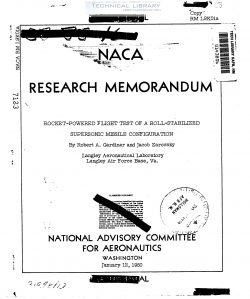naca-rm-l9k01a
- Version
- 91 Downloads
- 937.66 KB File Size
- 1 File Count
- April 26, 2017 Create Date
- April 26, 2017 Last Updated
National Advisory Committee for Aeronautics, Research Memorandum - Rocket-Powered Flight Test of a Roll Stabilized Supersonic Missile Configuration

he results of a flight at supersonic speed of an automatically
roll-stabilized rocket-powered model incorporating a gyro-actuated
control system in combination with wing-tip ailerons are reported. The
autopilot consisted of a gyroscope directly coupled to the ailerons, the
hinge-moment torque being supplied by an auxiliary torque motor which
operated to precess the gyroscope to its centered position.
It is concluded that the combination of wing-tip ailerons and gyro-
actuated control system is a satisfactory method of obtaining roll
stabilization during zero~lift supersonic flight and that the method of
calculating rolling response by using a single-degree-of-freedom equation
is valid for zero-lift flight.
The Pilotless Aircraft Research Division_of the National Advisory
Committee for Aeronautics has undertaken a series of automatic—
stabiliZation tests. The object of the flight test reported herein
was to test the gyro—actuated control system in combination with wing—
tip ailerons at supersonic speeds. The autopilot consisted of a gyro—
scope directly coupled to the ailerons, the hinge-moment torque being
supplied by an auxiliary torque motor which operated to precess the
gyroscope to its centered position. The autopilot combines mechanical
simplicity and essentially zero—lag operation over a range of operating
conditions. This autopilot is of the same-type as the one used to
stabilize successfully a subsonic missile model as described in
reference 1.
In order to test this roll—stabilization system in zero-lift super—
sonic flight,-the measured autopilot characteristics were combined with
the estimated aerodynamic and mass characteristics of the missile model
for. preflight system analysis. System redesign was based on the analysis.
The improved system was first bench tested, then tested in free flight.
An auxiliary pair of ailerons was pulsed in a "square-wave“ pattern to
provide roll disturbances in flight so that the stabilization-system
performance could be determined.
| File | Action |
|---|---|
| naca-rm-l9k01a Rocket-Powered Flight Test of a Roll Stabilized Supersonic Missile Configuration.pdf | Download |

Comment On This Post